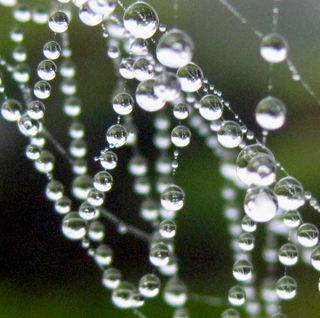 Spiders webs, dripping in dewy beaded jewells; hedgerows brimming with gloriously colourful ripe and ripening delicious fruits; the grains have all been harvested and the fields are in stubbles. It’s autumn (in case you hadn’t noticed).
Spiders webs, dripping in dewy beaded jewells; hedgerows brimming with gloriously colourful ripe and ripening delicious fruits; the grains have all been harvested and the fields are in stubbles. It’s autumn (in case you hadn’t noticed).
The abundance of a perfect summer for wildlife is everywhere. Chattering Linnets (Carduelis cannabina) and other small birds are forming large feeding flocks, perching on telegraph wires or diving down to glean the rich pickings left in the stubbles. It’s time for all life to lay down as much fat reserve as possible to survive the winter months. Growing an optimal winter coat through good nutrition can also make the difference between life and death during the worst of the weather. Animal survival depends on a good harvest, which can only come about through a good growing season of sun and rain.
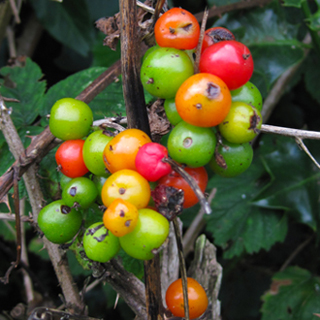 To the plantlife, autumn is a crucial time for distributing seed for the next generation. Securing a dependent relationship with animals, by providing attractive edible fruits, will guarantee success. We humans are as much a part of the consumption process as other animals, as we gather the bright, tasty fruits, nuts and seeds. This year has seen a much imporved harvest on last year (the gentle plip! plip! of airlocks in fermenting vessels is already testimony to the sheer quantities of fruit I myself have already gathered to make hedgerow wines). Although many of a plant’s seeds are destroyed through consumption and digestion, some escape. They may be accidentally dropped or discarded. They may even be designed to be eaten, digestion leaving them unaffected, to be expelled at optimal distance from the parent plant. The blackberry is a perfect example of this behaviour.
To the plantlife, autumn is a crucial time for distributing seed for the next generation. Securing a dependent relationship with animals, by providing attractive edible fruits, will guarantee success. We humans are as much a part of the consumption process as other animals, as we gather the bright, tasty fruits, nuts and seeds. This year has seen a much imporved harvest on last year (the gentle plip! plip! of airlocks in fermenting vessels is already testimony to the sheer quantities of fruit I myself have already gathered to make hedgerow wines). Although many of a plant’s seeds are destroyed through consumption and digestion, some escape. They may be accidentally dropped or discarded. They may even be designed to be eaten, digestion leaving them unaffected, to be expelled at optimal distance from the parent plant. The blackberry is a perfect example of this behaviour.
News from the sea
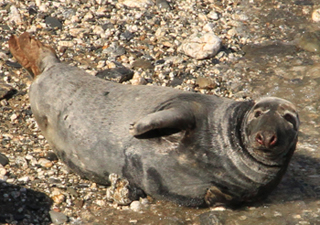 Throughout the summer, several observations have been made of dolphins visiting close in to the coast, indicating an increasing abundance of fish stocks in the hunting ground, which is good news. The most likely species seen here will be the Common dolphin (Delphinus delphis). If you’re close enough to see details, then they are identifiable by the ‘hourglass’ patterning along the flanks, and being dark grey dorsally and white ventrally. The beak, or rostrum, is rather long compared to other dolphin species. Other dolphins visiting our coasts may also be Bottle-nosed dolphin (Turslops truncatus), Striped dolphin (Stenalla coeruleoalba), Risso’s dolphin (Grampus griseus), and Harbour porpoise (Phocoena phocoena).
Throughout the summer, several observations have been made of dolphins visiting close in to the coast, indicating an increasing abundance of fish stocks in the hunting ground, which is good news. The most likely species seen here will be the Common dolphin (Delphinus delphis). If you’re close enough to see details, then they are identifiable by the ‘hourglass’ patterning along the flanks, and being dark grey dorsally and white ventrally. The beak, or rostrum, is rather long compared to other dolphin species. Other dolphins visiting our coasts may also be Bottle-nosed dolphin (Turslops truncatus), Striped dolphin (Stenalla coeruleoalba), Risso’s dolphin (Grampus griseus), and Harbour porpoise (Phocoena phocoena).
We are now entering grey seal pupping season, and the Roseland has a number of secluded beaches and small caves, where mothers have given birth to pups in the past. If you are lucky enough to spot a white coat pup in one of these places then keep a good distance away, as interferance may cause the mother to abandon it. She will undoubtedly be nearby and probably have spotted you before you see her. Older pups appearing on beaches with frequent public access will probably be independent of the mother, but still should be left alone unless clearly in trouble. In that case, call the British Divers Marine Life Rescue Hotline on 01825 765 546 (office hours) or 07787 433412 (out of hours) in the first instance.
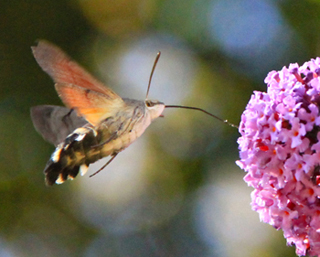 In the last edition of Nature Notes I mentioned that I had seen the enigmatic Hummingbird Hawk moth (Macroglossum stellatarum), but was unable to furbish readers with an image. Well at last I can! I was lucky enough to find one humming around a buddleia, which stayed long enough to be captured on camera. These animals are fascinating to watch as they probe their seemingly impossibly long proboscis into tubular flowers whilst on the wing.
In the last edition of Nature Notes I mentioned that I had seen the enigmatic Hummingbird Hawk moth (Macroglossum stellatarum), but was unable to furbish readers with an image. Well at last I can! I was lucky enough to find one humming around a buddleia, which stayed long enough to be captured on camera. These animals are fascinating to watch as they probe their seemingly impossibly long proboscis into tubular flowers whilst on the wing.
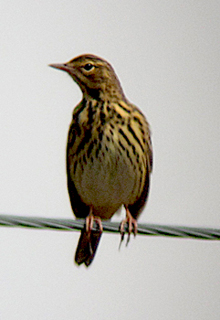 Other sightings in August and September included the red-listed Yellow wagtail (Motacilla flava) and Tree Pippit (Anthus trivialis) (depicted), as well as Clouded Yellow butterfly (Colias croceus), all around Commerrans. We were also accidentally visited by a Lesser Yellowlegs (Tringa flavipes) at Place, seen associating with Redshank (Tringa totanus), to which it is quite similar. This species is from the Americas, breeding in the far north and migrating to the south in winter, so the individual concerened had migrated somewhat off course. This is not a very rare occurrence but is, nonetheless, unusual.
Other sightings in August and September included the red-listed Yellow wagtail (Motacilla flava) and Tree Pippit (Anthus trivialis) (depicted), as well as Clouded Yellow butterfly (Colias croceus), all around Commerrans. We were also accidentally visited by a Lesser Yellowlegs (Tringa flavipes) at Place, seen associating with Redshank (Tringa totanus), to which it is quite similar. This species is from the Americas, breeding in the far north and migrating to the south in winter, so the individual concerened had migrated somewhat off course. This is not a very rare occurrence but is, nonetheless, unusual.
Cirl project latest
The Cirl bunting reintroduction project is now entering its autumn phase. We have probably recorded all the broods that successfully fledged this season. At the last count there were 28 fledged broods produced across 27 recorded pairs, with an average of approximately 2.4 young per pair. The precise statistics have yet to be verified, but the outcome this year has been much better than last year.
Giving Nature a Home this month in the garden
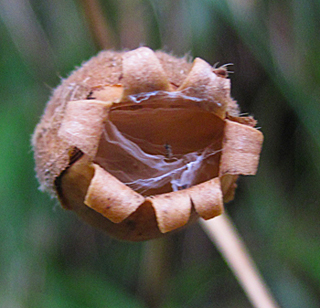 Many plants, both wild and cultivated, have hollow stems and seed heads, making them perfect homes for insects and spiders. So don’t be too garden tidy, and enjoy some of the beautiful forms that plants create for their seeds that also double as homes for small creatures. Depicted here is the delicate pot of a campion seed head, which has been occupied by a tiny spider.
Many plants, both wild and cultivated, have hollow stems and seed heads, making them perfect homes for insects and spiders. So don’t be too garden tidy, and enjoy some of the beautiful forms that plants create for their seeds that also double as homes for small creatures. Depicted here is the delicate pot of a campion seed head, which has been occupied by a tiny spider.
There’s no need either to buy those fancy bug houses that were made to be pleasing more to our eyes than their potential occupants. Instead, gather and cut bundles of hollow stems, tying them together and placing them in parts of the garden where they are protected from the worst of the weather. They can also be bundled into lengths of tubing such as drainpipe, and hung up in bushes and shady corners.
All Photography by Sarah E Vandome
Enjoy more Roseland wildlife and landscapes – visit my Heart of Roseland Facebook feature.

